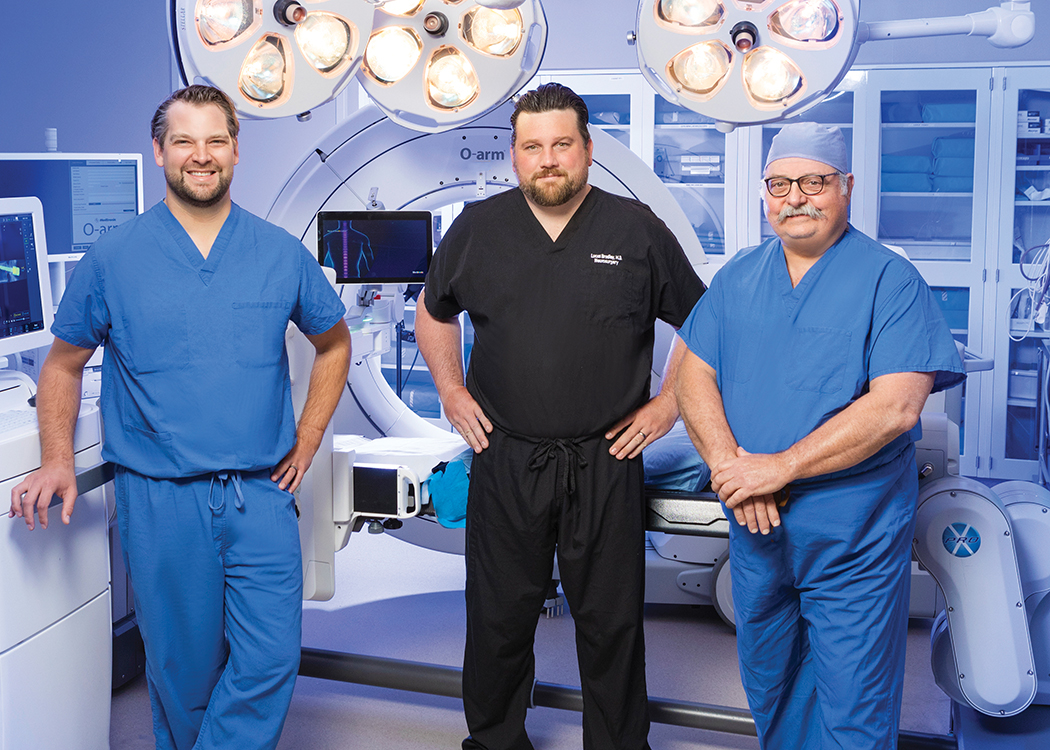Baxter Health Offers Mazor Robot Surgical Laser
- Category: Pulse
- Posted On:
- Written By: Dwain Hebda

When Dr. Allan Gocio graduated medical school in 1978, about the only lasers that were in the public consciousness were those appearing in the previous summer’s blockbuster movie “Star Wars.” Times have certainly changed from those days, as Gocio is quick to admit.
“We got our first CT scanner when I was a junior medical student. We didn’t get an MRI scanner until I’d been in practice about four years,” he said. “The medical technology has really progressed since then.”
Staying in the medical field for four decades as he has, Gocio has had the opportunity to put his hands on many of those advancements, the most recent being the Mazor Robot surgical laser, which came into service at Baxter Health last summer.
“The Mazor Robot actually builds on a concept that already existed called navigational surgery,” he said. “This is where you take imaging of the patient you’re working on, whether it’s the brain or the spine, and you use virtual images to guide you.
“The robot takes the next step forward with this technology by using a robotic arm as an aiming device and a tool holder to position you for your surgery, regardless of what area of the body you’re working on. It gives you a much more accurate placement of spinal hardware, which is what we’re using it for.”
If the Mazor Robot sounds like something unexpected in a hospital the size of Baxter Regional, it’s because you generally don’t find it outside of much larger health care facilities.
“This technology is very rare for a hospital our size, but then, it’s very rare for a hospital our size to have three neurosurgeons, too,” said Dr. Lucas Bradley. “I’d say there are several other hospitals in the state that are utilizing a robot of some sort, but they’re much larger than we are.
“It’s a big advantage for us to be able to offer the Mazor Robot. Every medical branch, surgical or nonsurgical, is becoming more and more complex with more and more devices and technology. You have to be able to provide the most up-to-date care using this kind of equipment; there’s just no way around it. Baxter Regional’s willingness to invest in that technology and training is huge.”
Bradley said the Mazor replaces technology that, while highly assistive in navigating the patient, still relies on the surgeon’s hand-eye placement of both hardware and the screws to hold it in place. With the new machine, the robot guides the placement of screws with far more accuracy than any human being can.
Dr. Adam Smitherman said the big advantage to using the robot comes down to developing a more detailed working plan for the operating room.
“Preplanning is a big part of that,” he said. “Everybody always thinks about spine surgery and having problems with that, especially taking into effect the global spine itself. This lets us think about ways we can help correct things as a whole while focusing on smaller segments. We can actually take a look at everything and see how we may affect that overall alignment better by preplanning these screws.
“Being able to line up incisions or prebend rods also helps, making surgery even more minimally invasive. It just makes it a much smoother process for us and the patient, all-around.”
Smitherman also said the robot laser allows for less invasive surgery across a wider patient population base.
“I think the part that’s going to be really exciting with it is where we can use it for scoliosis,” he said. “Being able to use this for minimally invasive correction of scoliosis broadens our window for patients who need correction. We may be able to offer surgery to patients who wouldn’t be candidates today, people who are older and wouldn’t be able to tolerate a big, open surgery.
“This device helps decrease blood loss, it helps decrease infection rate and it helps decrease OR time. That is where it shines, on the differences between doing the open procedures and the minimally invasive procedures.”
The full application of the technology is yet to be realized. Gocio noted in some areas, the Mazor Robot is being used to remove brain tumors and other delicate procedures. He said while there’s currently no plan to apply Baxter Regional’s device in this manner, the future is ripe with possibilities.
“Robots will become more sophisticated. Right now, the robot is mainly a tool holder and a positioner or a guide,” he said. “There will be multiple arms, ultimately, with multiple devices that connect, and there will be more robotic overlay on the surgeries.
“On the horizon, we’ll move into the cervical spine region, the neck area, which is much more complex and a much more dangerous place to operate. Removing bones, decompression of the spine or manipulation of the bones safely is the future. Not just guiding hand tools to the proper alignment and proper trajectory, but also manipulating the tools to do more of the work.”



.jpg)